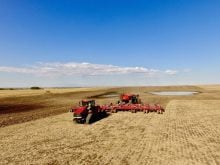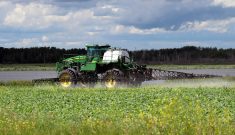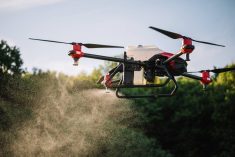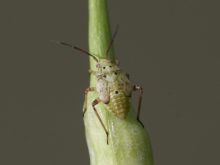Farmers have several things they must think about when choosing the right time to spray. Important considerations include application windows and time of day, but the obvious question is — is it too windy out?
“The wind speed is really the single most important factor that everyone uses to determine whether it’s safe to spray today or not,” says Tom Wolf, a sprayer expert and scientist at Agrimetrix Research and Training based in Saskatoon, Sask.
Wolf, also known as “The Nozzle Guy,” says too much wind can lead to coverage issues due to lost product, in addition to harmful spray drift. However, he believes it’s better to spray with some wind than no wind at all.
Read Also

Claas brings 1000 Series SP forage harvesters to Canada
In mid-August, Claas unveiled its new line of Jaguar forage harvesters at an event in Visalia, California, deep in the heart of that state’s dairy region.
When it’s calm and there’s a temperature inversion, spray droplets can become suspended above the ground and slowly drift with the colder air close to the ground as it moves into lower areas.
“We know that in an inversion, if there is a small amount of drift, you can harm very large areas adjacent to the field,” says Wolf. “We’ve seen entire quarter sections affected by inversion drift.”
According to Wolf, that’s unlikely to happen if it’s windy, especially if it’s sunny out, due to mechanical air turbulence (caused by wind) and thermal air turbulence (caused by the sun).
Both forces act to move the spray cloud up into the atmosphere, reducing its effect on the ground.
“The majority of it stays airborne and then becomes diluted to a less harmful concentration,” he says.

Wolf believes some wind is generally preferable for spraying. That’s because by dispersing droplets upwards and downwards, it can dilute a spray cloud quickly.
Another advantage is since winds tend to be reasonably steady in their direction and velocity, this makes it easier to identify downwind areas that might be affected by spray drift. Wolf says weather forecasting models have become increasingly reliable in predicting how long a wind will blow from a certain direction, providing farmers with an accurate way of assessing that risk.
Wolf maintains spraying can be done safely in breezy conditions, as long as farmers understand what the risks are and take precautions to manage them. Here are 10 tips from Wolf for reducing drift risks and optimizing pesticide coverage when spraying in the wind.
Top 10 tips
1. Know what’s down wind and what could harm it: Survey fields on all sides of the parcel you’re spraying. Try to avoid spraying fields that have sensitive areas downwind, such as water bodies, wetlands, shelterbelts, pastures or residential areas.
If you can’t avoid being upwind of these areas, make sure to check and obey the buffer zone restrictions on the product label, which should indicate if the product could have harmful effects in water or on land, or both. If you feel that drift is unavoidable and someone might be affected by it, talk to those people first before spraying.
2. Use a low-drift nozzle: Low pressure air-induced nozzles operated at 50 to 60 pounds per square inch generally will be low drift, but there are even lower drift models available.
3. Use a coarser spray: For best results in the wind, sprays should be coarse to very coarse, as described by the manufacturer. Dicamba labels call for extremely coarse to ultra-coarse sprays. Achieving an ultra-coarse spray may mean having to buy new nozzles.
Wolf considers the arrival of coarser sprays, which produce bigger droplets, to be one of the biggest developments in sprayer technology. “(It) widens our window to spray when we thought maybe we shouldn’t be spraying, but we actually can,” he says. “We can spray safely when it’s a little windier. The nozzles make that possible.”
With adjustable multiple nozzle bodies on many sprayers, switching the nozzles up is no longer as big of a job as it used to be, Wolf notes. “It’s easier for growers to match spray droplet size to field weather conditions.”

4. Consider using a dicamba tip: Wolf says when it comes to nozzles, it’s common sense to have everything you might need on hand when you’re out in the field. He believes that should include one of the newer nozzles designed for dicamba products.
Wolf considers them to be useful tools in windy conditions, even if you’re not applying dicamba. Rather than stopping and waiting for the wind to subside, farmers can switch to a dicamba tip with only a minimal drop in product performance due to poor coverage. “I find these nozzles to be a very good option when the conditions are unfavourable.”
5. Add water: A coarser spray means fewer droplets, so it’s a good idea to select a water volume that’s a little higher than the recommended minimum on the product label. The added spray pressure can improve coverage as well as provide slightly better canopy penetration. Adding more water can also make the spray less potent and therefore less harmful if it does drift.
6. Choose a product that can handle large droplets: One example of a product that can handle large droplets is Enlist, which requires at least a coarse spray. Glyphosate products are well suited to coarse droplets. Some contact active ingredients (Groups 6, 14 and 15) commonly mixed with glyphosate perform less well than other actives (Groups 2 and 4).
7. Consider a low-drift adjuvant: Products like Interlock or Valid have been shown to reduce driftable fine particles under 150 microns in size by between 40 and 60 per cent without adding significant volume in larger droplets.
8. Keep your boom low: Lowering your boom is right behind coarser sprays as the most effective methods for reducing drift. Low drift sprays require at least a 100 per cent overlap, which is the edge of one nozzle spray pattern to the centre of the adjacent pattern. For most nozzles, a boom height close to 20 inches is enough to achieve this overlap.
9. Keep it slow while spraying: Maintaining a reasonably slow travel speed will help limit the amount of fine droplets that hang behind the spray boom, and it reduces air turbulence and dust kicked up from the sprayer wheels as well. A slower speed also makes low booms more practical as there’s less boom sway. “We all know that going slower is a very good way to maintain a better boom height,” says Wolf.
10. Avoid headwinds: Take the wind from the side when you’re traversing the field if you can, as going straight into the wind creates a lot of extra drift.
Wolf stresses his suggestions don’t mean anyone should ever consider spraying when drift is at an unacceptable level. He says risk mitigation should always be the governing factor when deciding if it’s a good time to spray or not.
















